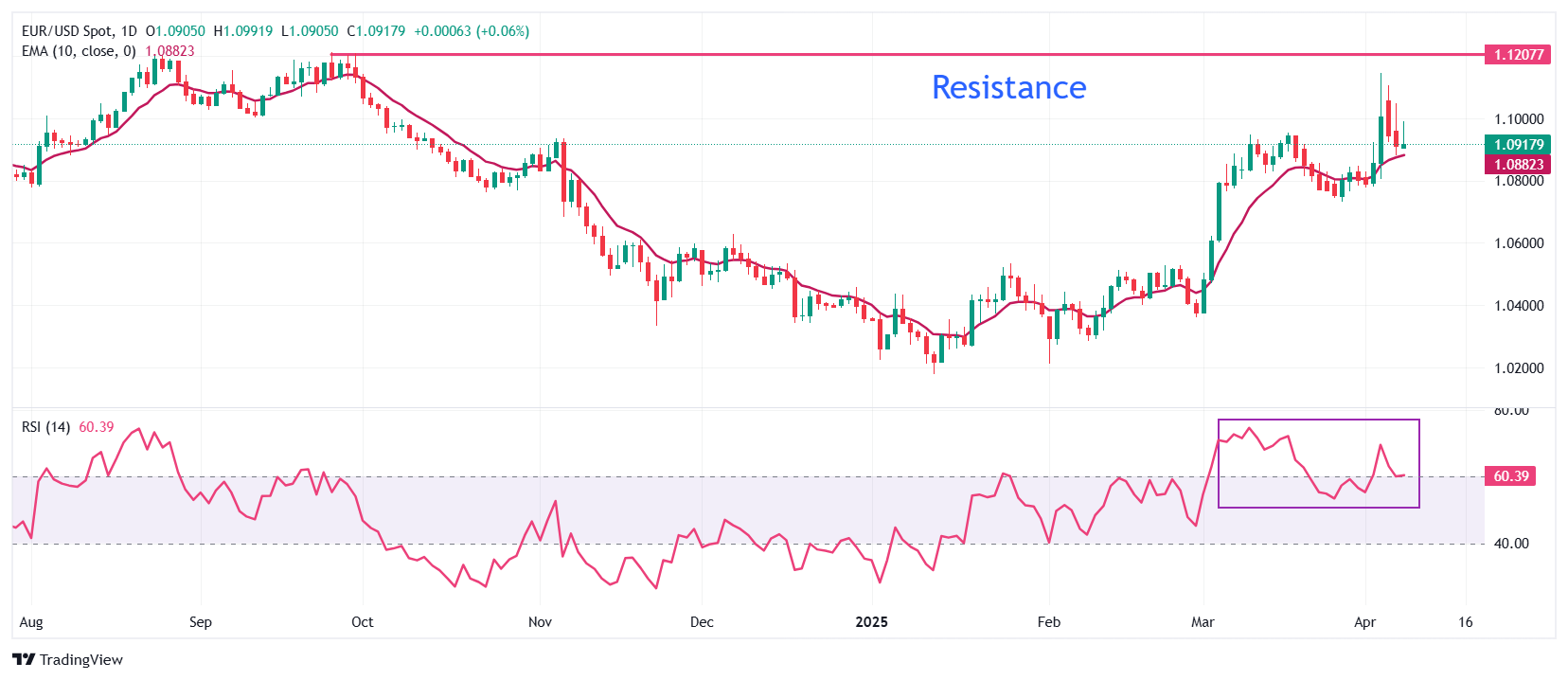-
EUR/USD slips toward 1.0900 as the US Dollar strengthens ahead of Trump’s key trade discussions.
-
Trump has warned of an additional 50% tariff on China in response to its retaliatory measures from last week.
-
Traders eye the upcoming Eurozone finance ministers’ meeting for potential responses to escalating US tariffs.
EUR/USD retreated sharply on Tuesday, giving up all its intraday gains to hover near the 1.0900 mark during the North American session. The pair came under pressure as the US Dollar (USD) rebounded, driven by easing fears over a full-blown trade war between the United States and its major trading partners. The US Dollar Index (DXY) climbed back toward 103.35, recovering most of its earlier losses.
This recovery followed comments from US Treasury Secretary Scott Bessent, who noted that many trade partners are urging Washington to negotiate tariff agreements, adding that President Trump will be directly involved in the talks. White House Economic Adviser Kevin Hassett echoed this sentiment, stating that the administration aims for "fair and reciprocal trade" and is preparing a structured plan for tariff negotiations.
Expectations of softer tariffs and trade barrier reductions from the US have temporarily eased recession concerns and boosted the USD. Last week, President Trump had shocked markets by announcing sweeping tariffs — a 10% universal base tariff along with additional levies aimed at correcting trade imbalances. The announcement had sparked fears of economic fallout and triggered bets on a possible rate cut by the Federal Reserve in June. CME FedWatch now shows a strong probability of such a cut.
Looking ahead, markets will turn their attention to key US economic indicators, including March’s Consumer Price Index (CPI) and Producer Price Index (PPI), due Thursday and Friday, respectively.
Despite the temporary relief, tensions between the US and China persist. On Tuesday, China’s Ministry of Commerce condemned Trump’s threats to raise tariffs by another 50% unless Beijing drops its retaliatory 34% duties, calling it “a mistake on top of a mistake” and vowing to “fight to the end.”
Daily Digest – EUR/USD under pressure amid mixed sentiment
- The Euro also came under pressure as dovish signals emerged from the European Central Bank (ECB). Several ECB policymakers, including Italy’s Cipollone, France’s Villeroy de Galhau, and Greece’s Stournaras, expressed support for further policy easing.
- Stournaras even indicated that US tariffs are unlikely to deter a potential rate cut in April, though he acknowledged they may reduce Eurozone GDP growth by 0.3–0.4% in the first year.
- Stournaras also emphasized the need for a more accommodative monetary stance in 2025, though he cautioned that rising inflation could delay policy normalization. In the meantime, market watchers are closely monitoring the potential fallout from US-EU trade friction, which could spark a transatlantic trade war.
- Eurozone finance ministers are set to convene in Warsaw on Friday to evaluate responses to the US tariffs. Ahead of the meeting, Polish Finance Minister Andrzej Domański warned that disrupted supply chains and rising costs could hurt European growth and put consumers at risk due to inflationary pressures.
- EU Trade Commissioner Maroš Šefčovič struck a more conciliatory tone, proposing a “zero-for-zero tariffs” deal for cars and industrial goods—a move welcomed by investors.
Technical Outlook: EUR/USD tests support at 1.0900

From a technical standpoint, EUR/USD has pulled back to test the psychological 1.0900 level. The pair remains above the 10-day Exponential Moving Average (EMA), currently near 1.0888, indicating that the short-term bullish trend is still intact. The 14-day Relative Strength Index (RSI) also holds firm around 60.00, suggesting sustained upside momentum.
On the downside, key support lies at the March 31 high of 1.0850. On the upside, the September 25 high at 1.1214 remains the primary resistance target for Euro bulls.





